Site blog
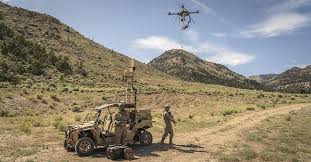
Deal with UAS Pioneer, Formerly CyPhy Works, Includes Intellectual Property, Multiple Patents
ARLINGTON, Va., October 2, 2019 ― FLIR Systems, Inc. (NASDAQ: FLIR) announced that it has acquired the intellectual property (IP) and certain operating assets of Aria Insights, Inc. Terms of the deal are not being disclosed.
Previously known as CyPhy Works, Inc., Aria pioneered the development of tethered small unmanned aerial systems (sUAS). Founded in 2008 by iRobot co-founder Helen Greiner and backed by several top technology investors, Aria notably developed the Persistent Aerial Reconnaissance and Communications (PARC) tethered drone. The company ceased operations in March 2019.
Tethered drones connect to a base station or vehicle by microfilament wire, which provides both continuous power and secure communications. For certain applications, a tethered drone offers advantages over a free-flying UAS, enabling sustained operations on longer missions and persistent situational awareness so users can perform intelligence, surveillance, and reconnaissance (ISR) functions.

The Aria assets will be integrated into FLIR’s Unmanned Systems and Integrated Solutions Division, augmenting the company’s industry-leading technology portfolio built from its acquisitions of Prox Dynamics in 2016 and Aeryon Labs and Endeavor Robotics earlier this year.
“Tethered UAS systems are becoming an increasingly valuable tool for force protection, border security, and critical infrastructure protection,” said David Ray, president of FLIR’s Government and Defense business. “Aria’s innovative technology and IP assets will enable us to enhance current capabilities and advance the range of solutions we can deliver to customers in this growing market segment.”
“We’re pleased to complete the sale of our assets to FLIR Systems,” said Lance Vandenbrook, former CEO of Aria Insights. “We are proud of the technology our team developed through the operations of CyPhy Works and Aria, and we believe FLIR offers the best opportunity to see it make a difference and support critical missions in the years ahead.”
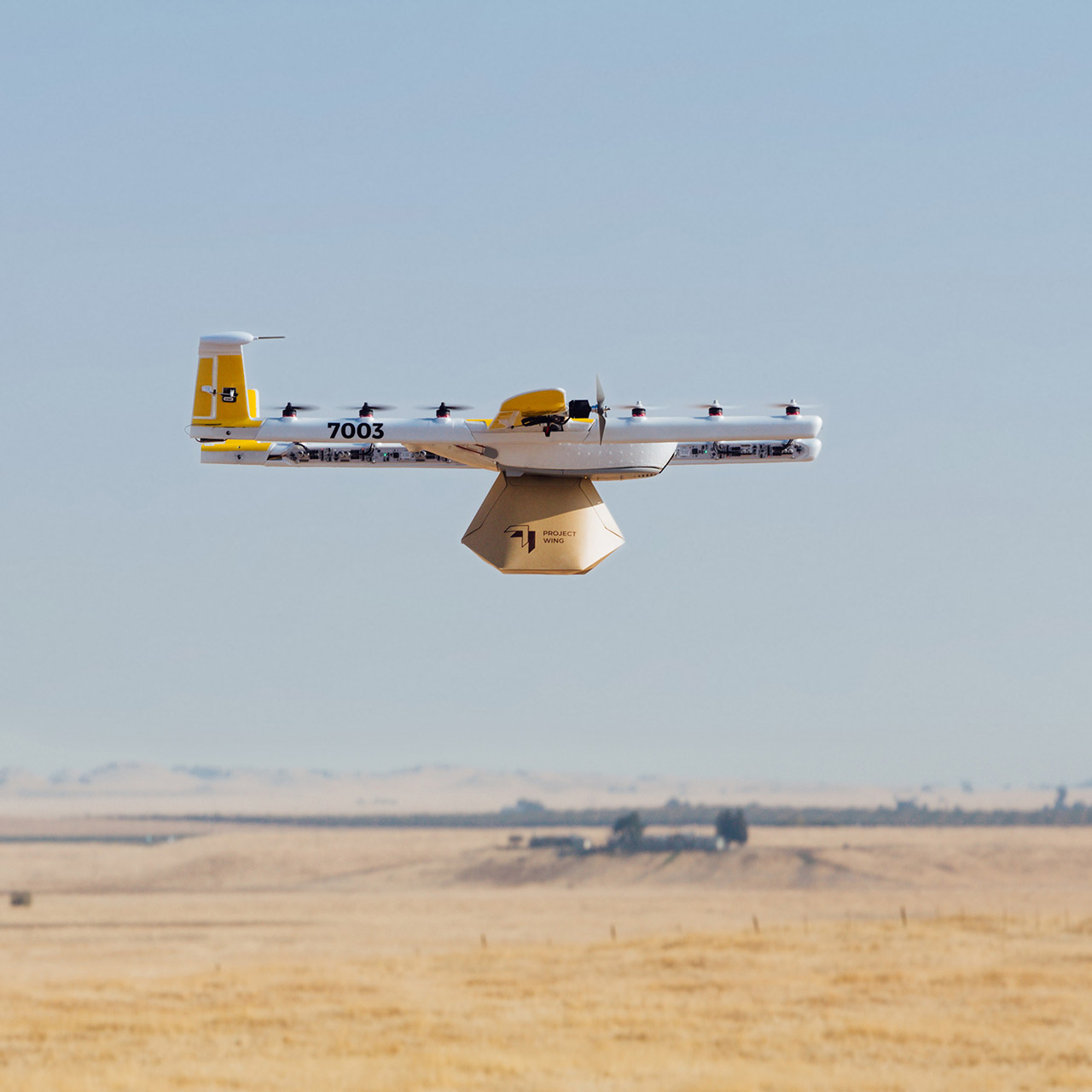
Photo credit : Google Wing
FedEx (FDX) has teamed up with Alphabet’s (GOOGL) Wing to make drone delivery a reality. On September 19, Google’s sister company announced that it’s launching a test program for drone delivery in Virginia next month. If the companies succeed in their tests, it will give them a massive advantage in the autonomous delivery space.
Alphabet’s Wing has selected the southwest Virginia town of Christiansburg, which has a population of roughly 22,000, for the pilot program. According to Wing’s press release, FedEx Express customers who opt for drone delivery will receive packages through this service. The company also said it would not charge for deliveries throughout the test period.
Apart from FedEx, retailers Walgreens (WBA) and Sugar Magnolia have also collaborated with Wing for the pilot program. The launch program will test delivery services for over-the-counter medicines, food and beverages, and specific packages within a specified mile.
About Wing drone delivery
Alphabet’s wholly-owned subsidiary Wing is trying to develop technologies to make drone delivery a reality. Earlier it was part of the Google X program. However, Alphabet separated the project in 2018 to make Wing an independent company.
The company has been working with the US government since 2016 to test drone delivery. In April this year, it was the first company to receive a regulatory nod for delivering commercial goods. Wing’s drones weigh around ten pounds and can carry up to three pounds’ worth of packages. The drones can travel at a speed of over 70 miles per hour. However, in a single takeoff, they can only fly up to six miles.
We learned about the functions of Wing’s drones in a September 19 TechCrunch report. For pickups and deliveries, drones will stay over 20 feet off the ground. For pickup, Wing’s drones will lower a tether, and a human operator will hook the package. The report states that the parcel will be dropped via the same rope or chain once the drone arrives at the delivery location.
FedEx countering rising Amazon threat
Since the beginning of 2019, FedEx has been investing heavily in autonomous delivery solutions for short-range deliveries. Automating last-mile delivery could drastically reduce the company’s operating expenses and help it deliver better services to customers.
In February, the company announced that it was experimenting with an autonomous delivery robot–the FedEx SameDay Bot–for last-mile delivery. The logistics giant has collaborated with the likes of Pizza Hut, Walgreens, Target (TGT), and Walmart (WMT) on the SameDay Bot delivery program.
FedEx’s foray into autonomous delivery services reflects its awareness of the rising threat from Amazon (AMZN) and UPS (UPS). Since last year, logistics companies have been considering the fact that Amazon could pose a greater risk to their businesses in the future.
Amazon has been aggressively investing in enhancing its own logistics infrastructure. The e-commerce giant has grown its air cargo fleet to 70 and has added over 10,000 delivery vehicles.
Additionally, the e-retailer is trying to lower its dependency on courier companies for last-mile delivery. It revealed its ongoing experiment on a six-wheel electric hamper called Amazon Scout in January. Moreover, Amazon received regulatory approval for drone delivery in June this year.
Considering the rising competitive threat, FedEx is cutting ties with Amazon to focus on the broader e-commerce delivery market. In 2019 so far, the logistics giant hasn’t renewed two delivery contracts with the e-retailer. Amazon delivery contracts accounted for 1.3% of FedEx’s total revenue in fiscal 2019.
FedEx’s rival UPS has also joined the autonomous delivery vehicle race. Last month, the company announced that it was buying a minority stake in autonomous tech startup TuSimple for an undisclosed amount. UPS and TuSimple are trying to develop and deploy technologies to fully automate long-haul commercial trucks.
WRITTEN BY ANIRUDHA BHAGAT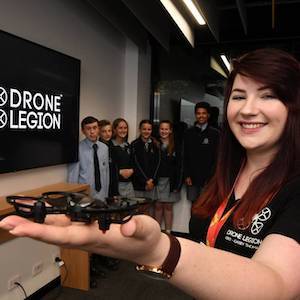
Melbourne-based Girl Geek Academy has acquired international initiative SheFlies to further its mission to teach one million women to learn technology by 2025.
SheFlies is a suite of programs designed to increase gender equality in tech spaces like drones, space and aviation.
The programs are designed to celebrate the achievements of women already within the fields and forge pathways and opportunities for other girls and women to enter the industry and thrive.
SheFlies has already championed young female techpreneurs like Casey Thomas and Dr Catherine Ball.
Casey Thomas (pictured) is the CEO and founder of the game Drone Legion; an interactive virtual reality drone racing simulator based on the sport of drone racing.
Drone Legion has been featured by the AFL at an esports tournament, the Melbourne Open tournament, and many other sporting events.
Dr Catherine Ball is an author, founder and ethics advocate working across global projects where robotics and drones can be used to foster environmental protection.
Her company, World of Drones Education, seeks to empower, educate and lift teachers and educators, industry and academia with friendly, approachable and free resources and networking.
CEO and co-founder of Girl Geek Academy, Sarah Moran, says the acquisition of SheFlies will enable the self-dubbed 'girl gang' to better equip women with skills to enter the fields of the future.
"SheFlies is our exciting new initiative to increase women representation, capacity and cooperation in the fabulous fields of drones, space and aviation," says Moran.
"There is a lot of great work going on above the ground, and some women champions who have greatly contributed to that. We want to celebrate their achievements and showcase not only those who have come before us, but those are next to go."
"When it comes to jobs in the air, women are still enormously outnumbered. For example, women currently account for only around three percent of pilots and one percent of aircraft engineers in the aviation industry globally. We're going to help change this."
Written on the 27 September 2019 by David Simmons
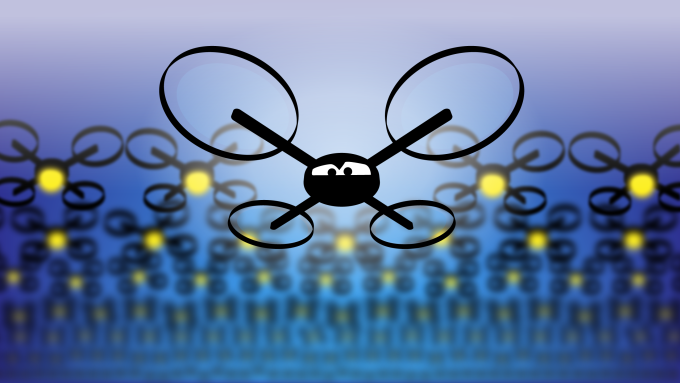
DJI announced two new drones and a new initiative to support first responders during natural disasters and recovery missions with drone technologies as it moves to consolidate its position as the leading drone technology provider.
The company hyped its new multispectral drone as the world’s first fully integrated multispectral imaging drone to enable more efficient land management, and the Agras T16, which is a spray drone to apply fertilizers and pesticides to field crops and orchards.
For first responders, the company is working with pre-selected U.S.-based partners to equip state and local public safety agencies with hardware and software from the company. Initially DJI is working with public and volunteer institutions like the Los Angeles Fire Department, the Menlo Park Fire Protection District, Alameda County Sheriff’s Office and the volunteer-based Public Safety Unmanned Response Team North Texas. Companies distributing and managing services include FlyMotion and Axon (which was formerly known as Taser International).
These partnerships are being pursued even as the U.S. military has officially banned the use of DJI drones since 2017 because of security concerns. The military still purchases DJI drones on a case-by-case basis, but there have been a number of red flags raised by U.S. defense and intelligence officials over the potential threat that using Chinese equipment may pose to national security.
“This program builds on DJI’s growing commitment to the public safety industry, as more than 900 public safety organizations across the United States, including the Los Angeles Fire Department, are deploying DJI drones for lifesaving activities,” said Romeo Durscher, director of Public Safety Integration at DJI. “To date, at least 278 people around the world have been rescued from peril by drones, and this program will ensure that many more lives are saved by mitigating the risks to emergency responders on the ground and on the front lines of natural disasters.”
Drone hardware and software distributed through the program will include DJI’s most advanced technologies, including the DJI Matrice 200 series and Mavic 2 Enterprise series drones, accessories and batteries, powerful visual and thermal cameras, DJI’s FlightHub drone fleet management software, and DJI AeroScope for airspace management and unauthorized drone detection and mitigation. In addition, DJI will provide technical support, repair services and on-site manpower to help organizations more effectively and efficiently deploy drone technology in times of need.
“Over the past year DJI has focused on delivering enterprise-grade drone technology that enables some of the most sophisticated businesses and government agencies in America to safely and securely deploy drone technology into their daily operations,” said Mario Rebello, vice president and Americas Regional Manager at DJI. “This year we aim to put our easy-to-use drones in the hands of farmers, agronomists and land stewards to help manage their lands in a more efficient and environmentally friendly way, while also making sure we equip emergency responders with access to the industry’s best tools and support they need to rapidly respond and save lives during natural disasters.”
DJI also took the opportunity to show off its drones as a platform for other technology developers, with FLIR Systems introducing its first multi-gas detector integrated with the DJI Matrice 210 drone for applications in chemical, industrial and environmental monitoring. DJI is allowing for even more development with the creation of a DJI X-Port, a gimbal attachment that allows hardware developers to integrate their own sensors, cameras and arrays. The X-Port features built-in communication APIs, SkyPort integration and a gimbal debugging interface to bring more sensors to market.
Finally, the company introduced new service protection plans like the “Enterprise Shield Basic Renew,” which offers a reduced-price product replacement for a damaged drone within one year of purchase and a “Shield Plus Renew” plan, which offers unlimited product replacements or free repair services within a year for the coverage amount a company purchases.
By Jonathan Shieber
By Andrew Mcdonald
Urban aerial soundscapes across Australia are poised to undergo a potential transformation in coming years as various drone industry interests look to push into undercapitalised low-lying airspace. If this forecast is accurate, one question (of the many) worth asking is “how could drone flight paths and the presence of drone base-stations affect the value of house prices?”
Before taking a shot at answering that question, it’s probably worthwhile providing some context about the manner in which commercial delivery drones are being introduced into Australia.
Wing unleashes delivery drones
One of the first tastes of the soundscape transformation was experienced in Bonython (ACT) between September 2018 and February 2019, when Wing (sister company to Google) unleashed its fleet of delivery drones on hapless residents following a half-baked community consultation.
After wading through the submissions to the Government inquiry into drone delivery systems in the ACT (Inquiry), it looks like the service left an extremely bitter taste in the mouths of the residents — much more bitter than the coffees that were being delivered by the Wing drones.
The submissions revealed, among many other negative impacts, that the noise of the delivery drones was particularly offensive to a large proportion of residents. The experience of the residents is also extensively documented on the Bonython Against Drones (BAD) webpage. One of the main gripes about the noise was the loss of amenity in the otherwise tranquil neighbourhood.

Interestingly, the Bonython trials didn’t stop Wing from later claiming that its commercial operations got off to a “successful start” in Australia. To the Bonython residents, such a comment might have felt like a slap across the face or a smashed burrito on the doorstep: yes, burritos were also on the drone delivery shopping menu in Bonython.

But I suppose it all comes down to how “successful start” is defined. Objectively, the Wing trial was a horrendous experience for most of the residents that were subjected to it. It was, however, a big success for Wing in the sense that Wing gained valuable data about how it should shape its drone delivery service going forward.
Overall, it looks like Wing — in the style of some of its Silicon Valley brethren — moved fast and broke things, but then fronted up at the Inquiry with promises to modify its behaviour (else risking another slap on the wrist). Fortunately, Wing looks to have started off on a much brighter note with its flight demonstrations and information stalls in Logan City (Queensland).
The potential impact on house prices
To get an anecdotal gauge on what impact drone flight paths and drone base-stations might have on property prices, I reached out to a number of real estate agents in Logan City and Bonython.
The question I asked Tony Miller, Principal/Director at Ray White Logan City, was whether he had seen any impact on the market values of properties as a result of the operation of drone delivery services.
Tony says:
“at this stage we’re not seeing an impact in Logan City as a result of the flight demonstrations and planned delivery trials, but that could change if the trial gets underway and really ramps up in intensity. If it does, it’s possible that different age demographics may be more sensitive to the presence of drones than others. For example, young generations seem to be a bit more accepting of new technologies compared to older ones.”
Tony continues,
“whether this flows through to market values is another matter. I’d hazard a guess that the presence of delivery drones in a neighbourhood of itself wouldn’t be enough to deter a potential buyer, unless that drone delivery service generated extreme levels of noise”.

The Bonython real estate agents that were contacted for this article are yet to respond. The article will be updated if a response is received. As a case study, it would be interesting to know the extent to which buying and selling (or rental) activity may have been impacted during the period of those drone trials.
What role will drone noise regulation play?
The shape of drone noise regulation — which is currently under development — may also have a bearing on the way drone delivery services are conducted. This may flow through to effects on buying and selling activity, and ultimately house prices. If the regulation is too lax, drone delivery services may operate with relative impunity to the detriment of society generally. If it’s too strict, it may stifle legitimate commercial operations and innovation.

So where does the appropriate balance lie? It’s a vexed question: one that policymakers and sections of the drone industry are presently grappling with.
Conclusion and advice
The point of this article was to provide a preliminary cursory look at the question of drone flight paths and house prices. In time, it is hoped that enough data will be gathered so that any link between drone flight paths (along with drone base-stations) and house prices can be better understood.
If you are concerned about moving to a neighbourhood that may have drone delivery services, you should conduct searches and also ask your real estate agent to see whether this is the case.
The Australian Civil Aviation Safety Authority (CASA) also has a dedicated drone delivery systems webpage with information about the locations of drone delivery systems and about areas they may be operating in in the future. It’s reasonable to assume that the number of areas listed on this page will grow in size and that in time there will be areas from areas other states and territories. It’s just a question of how quickly this may occur.

For operational reasons, it may also be reasonable to assume that more densely populated areas will be more difficult for drone delivery service providers to penetrate compared to those that are more sparsely populated. It’s also predicted that more affluent neighbourhoods, along with those neighbourhoods comprising older demographics, may — under the nimby (not in my backyard) catchcry — push back strongly against commercial drone delivery services.
* Andrew is the owner of droneadvice.com.au, a licenced drone pilot, a member of the Australian Association for Unmanned Systems (AAUS) RPAS Noise Advisory Group (RNAG) and has a personal company, Aeriography Pty Ltd, with an interest in the Australian drone sector generally. The role of RNAG is to provide relevant industry perspective and expertise to develop an AAUS / Industry position on the introduction of regulations concerning RPAS noise in Australia. RPAS means Remotely Piloted Aircraft System. You can email Andrew at amaccas@gmail.com and follow him on Twitter @2TalkPodcast
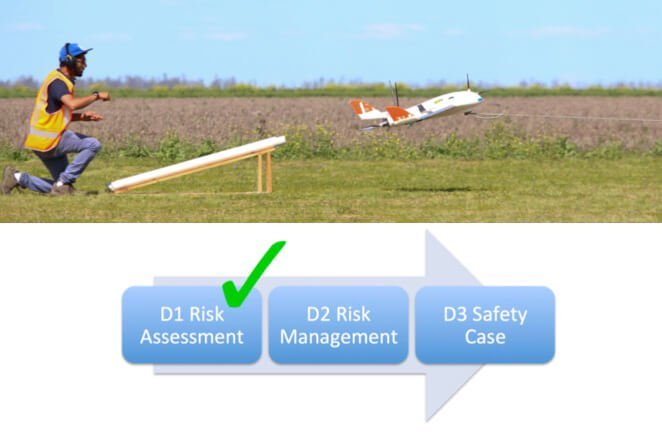
The UAV Challenge Technical Committee has now completed its reviews of the Deliverable 1 documents from teams that have entered the UAV Challenge Medical Rescue event that will be held in 2020.
After some clarifications from some teams, 47 teams have been given a Go decision and progress to the next stage. Those teams have a total of nearly 500 team members. Congratulations to all the teams.
ABES Engineering College (India)
Aerial Robotics Club at NC State (USA)
Aldora (Spain)AS Works (Canada)
Beam UAV (Australia)Cairo University UDC (Egypt)
Canberra UAV (Australia)Flight Labs UNSW (Australia)
Flow Design Team (Croatia)
Forward Robotics (Canada)
GriffinUAV (Thailand)
High Flyers (Poland)
ISAAC UAV (Thailand)
JetStream (Poland)
MAVlab TUDelft (The Netherlands)
MelAvio (Poland)
Monash Unmanned Aerial Systems (Australia)
NDVI Drone (Thailand)
OnPointUAS (Australia)
Pegasus (Thailand)
Phone It In (Australia)
PolyU Pharos (Hong Kong)
QUT Aero (Australia)
Rescue Dragons (India)
RhinoHawk UAV (USA)
RMIT Mighty Morphin Flying Rangers (Australia)
SRM UAV (India)
Sutherland Shire UAV (Australia)
Sydney RPAs (Australia)
TDIH (Australia)
Team Blaze (India)
Team Dhaksha (India)
Team Icarus (UAE)
Team Kalpana (India)
Team Pigeon (Australia)
Team Retired (Australia)
Team Rocket (Australia)
Team UAV (India)
UAS-DTU (India)
UASyd (Australia)
West Coast UAV (Australia)
WUThrust (Poland)
By PRESS

OTTAWA – The federal government is fining a rogue drone pilot for flying the device over downtown Toronto as crowds celebrated the Raptors‘ historic NBA championship win – and again during the victory parade four days later.
Transport Canada says it will serve up a fine of $2,750 to the individual, who was not identified, following its investigation into the incidents in mid-June.
The earthbound pilot broke multiple rules, steering the drone within 30 metres of another person and through the controlled airspace of Toronto’s skyscraper canyons – which sit within three nautical miles of an airport. The Transport Department says the violator flew the remote-controlled device – which was not registered – despite lacking drone pilot certification.
Transport Minister Marc Garneau says safety is his “No. 1 priority” and that pilots “must never put people or aircraft in danger.”
Celebrations after the Raptors’ historic win against the Golden State Warriors on June 13 carried on late into the night in Canada’s biggest city.
The daytime victory celebration on June 17 saw an estimated two million people flood the downtown core in an event that drew criticism for its planning, with some bystanders caught in the crossfire when gunfire erupted near city hall, injuring four.
By Staff The Canadian Press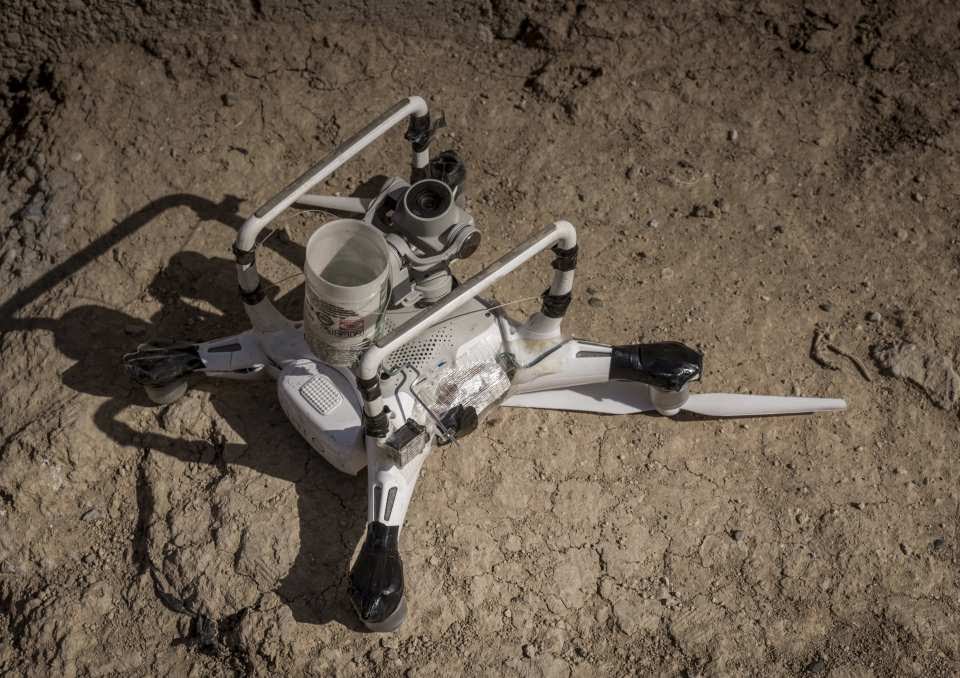
AN ISIS terrorist blew himself up when the drone bomb he was operating ran low on battery — and flew back.
The idiotic killer was targeting allied forces after the Battle for Mosul in northern Iraq.
He had customised his weapon to carry plastic explosive and planned to detonate it by troops based in the city.
But his plan backfired because he had forgotten to sufficiently charge the device.
Civilian drones — as weaponised by ISIS — automatically ‘boomerang’ back to their point of launch when they start to run out of power.
They are programmed to return to prevent owners losing their machines.
OPERATION SHADER
UK troops — including the SAS — are training Iraqi soldiers as part of Operation Shader and are plagued by drone attacks.
A security source said: “We receive intelligence from locals about enemy activity and tactics.
“We learned this idiot had wired up his drone with explosives but was killed when it’s batteries ran low and it flew home.
“With a weak signal for some reason it detonated over his head.
“This caused quite a laugh for us but the drone threat is very real. The fighter killed himself last year due to his own ineptitude, but is still keeping moral high today.” ISIS has become advanced in its use of drone weapons, which it dubs its ‘air force’.
A jihadi in a 2017 ISIS ‘teaser trailer’ featuring huge explosions after drone strikesThe battle for Mosul ended officially in 2017 but British troops are still training Iraqis there.
Although the battle for the city was won, the drone threat is ongoing.
DRONE THREAT
Customised commercial versions — such as the £1,200 Chinese-made DJI Phantom — are used as flying bombs or to carry munitions to drop.
The source said a common, simple and effective tactic is to push a hand grenade — with pin pulled — in a steel tube attached to the aircraft.
Once over the target the drone is remotely dipped so the grenade slides out of the tube, releasing the trigger mechanism.
Some grenades are adapted with fins attached to help them fly more accurately.
Iraqi security forces then came up with their own response, by attaching shuttlecock feathers to their own grenades, again dropped by drone, to help guide the munitions to the ground.
The source added: “Drone warfare is hugely effective for insurgents.
By Stephen Moyes
The drone operations accomplished a series of records and important achievements. The drones flew a total distance of 263 km over marine areas, in 24 flights, averaging a distance of 11 km away from operators in Beyond Visual Line of Sight (BVLOS) ops, and landed on the ocean every time, successfully gathering data of illegal fishing activities and for marine ecology efforts, demonstrating that the technology works and can be replicated to similar environments and projects.
The drones were equipped with a dual setup of cameras: a forward-looking camera with video downlink to long distances. The camera panned left to right in order to scout great portions of land or water or to lock-on on a point of interest while the drone loitered, which allowed a semi-permanent view of a particular area. The camera also recorded HD video which turned out very useful for post-flight analysis by the marine biologists and the enforcement team.
The second camera captured vertical imagery that was used to create high resolution orthomosaics which revealed further details of the area surveyed. The images were later geo-referenced and the data captured identified environmental issues, such as accumulation of plastic debris, and of sargassum seaweed which can cause deoxygenation of the water and block out sunlight, or fishers past activity, for example. The combined information provides a clear picture of how the atolls are being used by both animals and illegal fishers. The knowledge is then utilized to make changes or recommendations on the policies governing the use of the marine area, as well as for prosecution of the illegal activities.

The drones were normally launched from a beach, but the expedition team also successfully launched the drones from a small boat on numerous occasions.

For additional details read the full report here.
The drone
The Amphibious version of the Aeromapper Talon allows maritime operations by autonomously belly landing on water. It’s the perfect solution for scouting, data collection and mapping thanks to its dual camera set up and long-range video link, up to 2hr endurance and demonstrated BVLOS capabilities up to 30kms from the operators.
The only truly amphibious multipurpose fixed wing drone in the market today, it can sustain repeated operations in salt or fresh water. Ideal for applications such as:
- Fisheries
- Marshlands
- Marine research and conservation
- Search and rescue
- Water quality monitoring
- Off-shore infrastructure inspection
- Coastal surveying
- Hydrography
- Marine management
More information about the Aeromapper Talon Amphibious

Wreckage of a WING LOONG II reportedly shot down by a Turkish-made laser weapon in Libya in early Aug 19
Over the weekend I was intrigued to read a report posted by Army Recognition on 12 Aug entitled ‘Turkey uses laser weapon technology to shoot down Chinese UAV Wing Loong II in Libya,’ referring to an incident from 3 Aug 19. I tweeted about it, asking the question about why it had gone past largely unreported by mainstream commentators and traditional defence and aerospace press. It picked up quite a lot of interest over the weekend but nobody was able to add any further credibility to the initial source.
As this was of professional interest to me I did a little bit of reading to establish what was known about the reported engagement as this would represent the first use of a laser-based weapon to successfully shoot down an armed, unmanned combat ISR platform in combat. It was even more interesting due to the role-call of countries and actors directly or indirectly involved: Libya, GNA, LNA, UAE, Turkey, China - and not the usual major power proponents of military innovation.
It is reported that a UAE-operated, Chinese-manufactured MALE RPAS UCAV was engaged and shot down by a Turkish-built directed energy weapon, a vehicle-mounted laser, in Libya.
The USA and Russia may have more advanced directed energy weapons (DEW) programmes, however as the author of the Army Recognition article, Alexander Timokhin, points out: “ground-based combat vehicles with tactical-level lasers are not being built and used in Russia or the United States. This is done by the Turks.”
Libyan GNA forces had issued a statement and crash site photographs via Facebook on 3 Aug claiming they had shot down the RPAS near Misrata, reproduced here. It was also picked up by Akshita Aggarwal on Twitter the same day. But the incident has received very little mainstream commentary or analysis in the past fortnight in spite of, or perhaps due to, the involvement of non-traditionally dominant players in a complex theatre that attracts surprisingly little media coverage.
The US does not expect to install a production-standard laser-based weapon until 2021, on the destroyer USS Preble, although USS Ponce deployed to the Gulf in 2014 with AN/SEQ-3 Laser Weapon System and was authorised to employ it defensively.
In the UK a contract for the so-called Dragonfire laser weapon demonstrator was awarded in 2017 to an industry grouping managed by dstl and including UK-based weapons heavyweights. This demonstration was limited to assessing viability of laser weapons technology from the perspective of SWAP and effectiveness and is due to deliver a prototype capability demonstrator before the end of 2019.
In parallel to the capability demonstration, MoD is moving ahead with a procurement programme for directed energy weapons including laser, but has yet to get as far as the demonstration phase, only releasing a Prior Information Notice in Jul 19 and not expecting to move to trials until 2023.
Turkish manufacturers Aselsan and Roketsan have both sold production-standard DEW C-UAS systems. iHLS comment that the Turkish system used in this 3 Aug engagement in Libya was mounted on an off-road armoured car chassis and equipped with a Turkish-made optoelectronic guidance system that allows accurate aimpoint selection and holds the laser energy to the same point throughout the engagement, employing a continuous radiation mode without long interruptions to the “pumping” of the laser. If the reports are credible, this incident marks the realisation of a new threat vector to MALE RPAS operations that we should anticipate to proliferate rapidly outside the control of the ITAR regime.
Philip J.
Senior ISR Expert at Inzpire Ltd | UK ISR Warfare School graduate | RAF Reserves Officer
